|
I suppose my desire to build a boat goes back better than 30 years, to a Christmas when I asked Santa for plywood and screws to build a small johnboat of my own design.
Santa instead dropped off a molded plastic "Sportyak" 7 foot bath-tub-looking boat
that was a perfectly good boat for someone who needed a boat in order to go fishing
or hunting or as a dinghy for a large boat. It was perfect for someone who looked at
it as a means to an end, and not as the “end “itself.
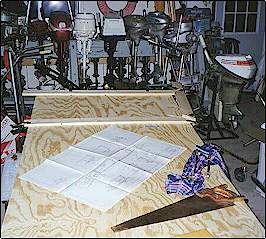 Fast-forward to 1998. I have just had a 22' by 24' garage built in the backyard; Fast-forward to 1998. I have just had a 22' by 24' garage built in the backyard;
we have acquired a computer along with internet access, and I was getting bored with
my then-current "fringe" boating activities, which centered on The Antique Outboard Motor Club (good group of guys; check-out their web sites. Previously I had belonged to the American Sternwheel Association, another good bunch with web sites.) Time to build a boat. In my internet travels I had stumbled across Jim Michalak's
website and the series of newsletters concerning his
AF4. This seemed to be the ideal boat for me; cheap and easy to build; capable of
overnighting, and a good match for my all-time favorite outboard motor, the 1957 through 1974 OMC
(Johnson/Evinrude) 18 hp.
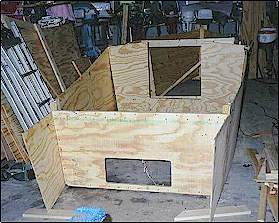 I purchased a set of plans (dirt-cheap @ $30.00) and began construction during the first week of October 2000, and launched for sea trials the second week of April 2001.
Not wanting to put too much money into my as yet unproven boat building skills, I elected to build "on the cheap". I used 5/8" BC pine exterior plywood for the bottom; 3/8" BC for the sides; 1/4" BC for the bulkheads, and 5.2 mm
lauan for the cabin roofs. As I was using thicker plywood for the sides and bottom than Jim recommends, and was using thinner stuff for the roof and bulkheads (to try to save some
weight) I ended up using about 13 sheets of plywood. If you follow th plans, you can get by with nine sheets. I purchased a set of plans (dirt-cheap @ $30.00) and began construction during the first week of October 2000, and launched for sea trials the second week of April 2001.
Not wanting to put too much money into my as yet unproven boat building skills, I elected to build "on the cheap". I used 5/8" BC pine exterior plywood for the bottom; 3/8" BC for the sides; 1/4" BC for the bulkheads, and 5.2 mm
lauan for the cabin roofs. As I was using thicker plywood for the sides and bottom than Jim recommends, and was using thinner stuff for the roof and bulkheads (to try to save some
weight) I ended up using about 13 sheets of plywood. If you follow th plans, you can get by with nine sheets.
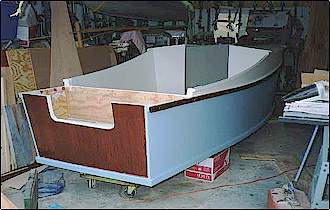 Since no one in the newsgroups or chat boards could agree on glues, I decided to experiment, and put the boat together with Weldwood and PL Premium. The only thing glued with epoxy is the 2" by 4" keel (another departure from the plans, which show (3) "keels" or runners on the bottom, measuring 1" by 4".) I applied two layers of seam tape to the chines, but did not cover any other parts of the boat with cloth, nor did I soak anything in epoxy. The fasteners are brass (not bronze) screws. Since no one in the newsgroups or chat boards could agree on glues, I decided to experiment, and put the boat together with Weldwood and PL Premium. The only thing glued with epoxy is the 2" by 4" keel (another departure from the plans, which show (3) "keels" or runners on the bottom, measuring 1" by 4".) I applied two layers of seam tape to the chines, but did not cover any other parts of the boat with cloth, nor did I soak anything in epoxy. The fasteners are brass (not bronze) screws.
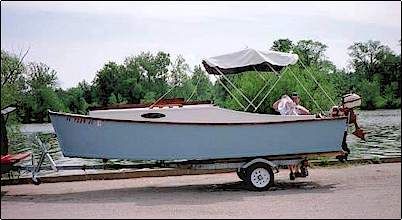 The other changes I made were to alter the sheer forward so as to present a "truck cabin" look rather than a "flush deck" look, and I completely redesigned the transom to
accommodate outboards larger than Jim approved of, and also to provide a secure mounting for a lifting bracket for a "trolling" engine and also for a swim ladder. The other changes I made were to alter the sheer forward so as to present a "truck cabin" look rather than a "flush deck" look, and I completely redesigned the transom to
accommodate outboards larger than Jim approved of, and also to provide a secure mounting for a lifting bracket for a "trolling" engine and also for a swim ladder.
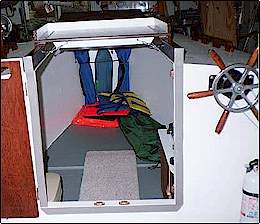 Jim's prototype AF4 , completed but bare of equipment, weighed in at about 300 lbs. (with a 3/8" bottom- Jim recommends going to 1/2"). Mine came in at 410 lbs, which was a little lighter than I thought it would. I have since loaded it down with assorted
junk such as running lights, cabin lights, C.B. radio, and oscillating fan, all powered by a lawn tractor battery. I have a 2-burner propane stove mounted on a cabinet Jim's prototype AF4 , completed but bare of equipment, weighed in at about 300 lbs. (with a 3/8" bottom- Jim recommends going to 1/2"). Mine came in at 410 lbs, which was a little lighter than I thought it would. I have since loaded it down with assorted
junk such as running lights, cabin lights, C.B. radio, and oscillating fan, all powered by a lawn tractor battery. I have a 2-burner propane stove mounted on a cabinet
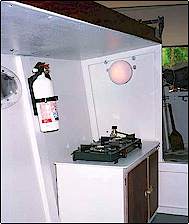 that may be removed from the cabin for use (but I have been using it in the cabin ; not too smart, probably.) I do have some safety gear; paddle, boat hook, (2) fire extinguishers, anchor with 150 ft of rode, etc. Most of this stuff I had laying around and nearly all of it was
acquired at flea markets, auctions, junk shops, etc. Very little was bought new, "off the shelf". that may be removed from the cabin for use (but I have been using it in the cabin ; not too smart, probably.) I do have some safety gear; paddle, boat hook, (2) fire extinguishers, anchor with 150 ft of rode, etc. Most of this stuff I had laying around and nearly all of it was
acquired at flea markets, auctions, junk shops, etc. Very little was bought new, "off the shelf".
Something I never leave "port" without, is my 40 lb tool box. I have lost track of how many times I have been able to repair other people’s problems on the water with the varied contents of that box.
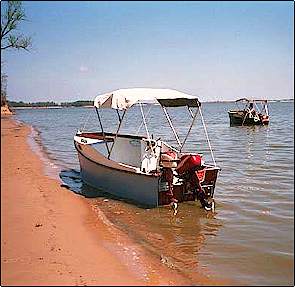 Even with all of this extra
weight, 18 hp is plenty for the AF4. In fact, I had a 10 hp engine mounted on it for the
Midwest Messabout. The boat handles well and leaves very little wake. It pounds no more at 15 mph than a
deep-vee does at 35 mph. It is as comfortable to sleep in as a plywood box can be. Overall, i am very satisfied with
the boat. It is meeting all of my needs, and has already exceeded the first quality that I was looking for in a home-built boat. I did not want a multi-year project; I wanted a boat that I could build over one winter. For as much as I enjoyed the building of this boat, summer is time to be on the water, not in the workshop. Even with all of this extra
weight, 18 hp is plenty for the AF4. In fact, I had a 10 hp engine mounted on it for the
Midwest Messabout. The boat handles well and leaves very little wake. It pounds no more at 15 mph than a
deep-vee does at 35 mph. It is as comfortable to sleep in as a plywood box can be. Overall, i am very satisfied with
the boat. It is meeting all of my needs, and has already exceeded the first quality that I was looking for in a home-built boat. I did not want a multi-year project; I wanted a boat that I could build over one winter. For as much as I enjoyed the building of this boat, summer is time to be on the water, not in the workshop.
|
![]()